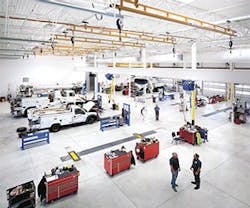What Does It Take to Maintain a Platinum Campus?
The new home of the sixth-largest customer-owned electric utility in the U.S. isn’t just LEED-certified – it’s aiming for net-zero energy and plans to get there with off-the-shelf technologies.
The East Campus Operations Center for the Sacramento Municipal Utility District (SMUD) was designed with a laser focus on minimizing energy consumption.
“Anyone can maintain these systems. They’re not custom-made or special, but the way they work together is unique,” explains Christopher Wilson, a project principal for Stantec, an engineering, consulting, and design firm, on the operations center. “Integrating the facilities management team from design and construction all the way to opening is critical. SMUD’s facilities team participated throughout the process and got to know the project.”
The campus features a 203,000-square-foot office building and five maintenance facilities for storage and repairs. It sits on 51 acres near some other industrial developments and once housed a mine, which offered a unique opportunity to install geothermal heating and cooling while the former mine was being filled.
“The pit was about 45 feet deep, but they only raised the elevation about 20 feet because not having the facility at street level actually provides security. You can’t see all the equipment as you drive by,” explains Wilson. “Rather than drilling or digging to bury the geothermal pipes, they were buried as new soil was brought onto the site. It was a very inexpensive opportunity to do geothermal heating and cooling.”
Other features supporting the utility’s green goals include:
- The six-story concrete office building features radiant heating and cooling.
- The north and south facades of the office building have windows for daylight, but enough shading to keep temperatures cool. The east and west facades have no windows in order to minimize heat gain.
- An underground cistern stores reclaimed water from all over the campus, including 75,000 gallons per year just from the office building. No drinking water is required for on-site landscaping.
The campus uses 36% less energy than required by ASHRAE 90.1, resulting in an annual energy savings of approximately $400,000 over a conventional building, Wilson says. The office building alone uses 60% less energy than a typical office structure in California. Thanks to a combination of energy efficient technologies and the 1.1 mW solar panel providing energy to the site, the center offsets over 3.7 kWh of electricity – enough to power just over 400 homes.
“This project has really brought a resource to northern California and the local industry,” says Wilson. “Now everyone can see how a net-zero building can be delivered at no additional cost.”
